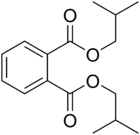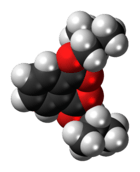Diisobutyl phthalate
Diisobutyl phthalate (DIBP) is prepared by esterification process of isobutanol and phthalic anhydride. Its structural formula is C6H4(COOCH2CH(CH3)2)2.
 | |
 | |
| Names | |
|---|---|
| Preferred IUPAC name
Bis(2-methylpropyl) benzene-1,2-dicarboxylate | |
| Other names
Diisobutyl phthalate Diisobutyl ester of phthalic acid 1,2-benzenedicarboxylic acid bis(2-methylpropyl)ester Di(isobutyl) 1,2-benzenedicarboxylate DIBP DiBP Palatinol IC | |
| Identifiers | |
3D model (JSmol) |
|
| ChEBI | |
| ChemSpider | |
| ECHA InfoCard | 100.001.412 |
| EC Number |
|
| KEGG | |
PubChem CID |
|
| RTECS number |
|
| UNII | |
CompTox Dashboard (EPA) |
|
| |
| |
| Properties | |
| C16H22O4 | |
| Molar mass | 278.35 g/mol |
| Appearance | Colorless viscous liquid |
| Density | 1.038 g/cm3 |
| Melting point | −37 °C (−35 °F; 236 K) |
| Boiling point | 320 °C (608 °F; 593 K) |
| 1 mg/l at 20 °C | |
| log P | 4.11 |
| Vapor pressure | 0.01 Pa at 20 °C |
| Hazards | |
| Main hazards | Harmful (Xn), Dangerous for the environment (N) |
| R-phrases (outdated) | R50/53-R62-R63 |
| S-phrases (outdated) | S36/37-S61 |
| NFPA 704 (fire diamond) | |
| Flash point | 185 °C (365 °F; 458 K) c.c. |
| 400 °C (752 °F; 673 K) | |
Except where otherwise noted, data are given for materials in their standard state (at 25 °C [77 °F], 100 kPa). | |
| Infobox references | |
DIBP is an odorless plasticizer and has excellent heat and light stability. It is the lowest cost plasticizer for cellulose nitrate. DIBP has lower density and freezing point than the related compound dibutyl phthalate (DBP). Otherwise, it has similar properties DBP and can often be used as a substitute for it. Its refractive index is 1.488–1.492 (at 20 °C, D).
Health issues
The concentration of a metabolite of DIBP, monoisobutyl phthalate (MIBP), has been steadily increasing in the urine of Americans over the period 1999–2008.[1]
Products in Taiwan made by Hebo Natural Products Limited (禾博天然產物有限公司) of China contained ginger contaminated with DIBP; 80,000 nutritional supplement capsules made with imported ginger powder were seized by the Public Health Department of Taiwan in June 2011.[2] In addition, soybean extract and olive leaf extract, both in powder form, were contaminated with DIBP and DBP.[3]
See also
References
- Center for Disease Control Fourth National Report on Human Exposure to Environmental Chemicals, Updated Tables, February 2011 CDC Exposure Report.
- News, Taiwan. "Taiwan News Online - Breaking News, Politics, Environment, Immigrants, Travel, and Health". Taiwan News.
- http://www.chinapost.com.tw/taiwan/national/national-news/2011/06/15/306275/Plasticizer-found.htmChina Post Archived 2011-06-25 at the Wayback Machine
